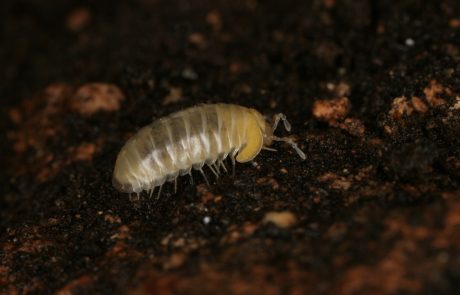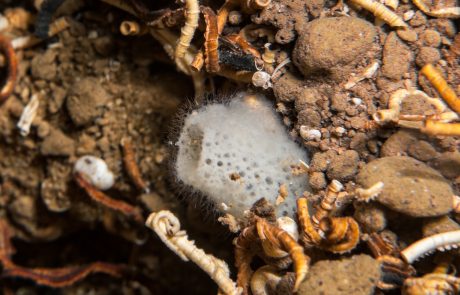
Cave fauna
The Characteristics of Cave Animals
The subterranean animals have evolved from epigean ancestors. Throughout the years, they have adapted to cave habitats and thus developed or acquired some new characteristics. Simultaneously, they lost or reduced many features in the process of the so-called regressive evolution.
Some of the main adaptations to the underground include the following:
- reduction of organs of vision
- development of senses other than vision
- loss of pigment
- integument dampening
- elongation of body parts
- slower metabolism
- longevity
- low reproduction level
- accumulation of fat reserves
- reduction of aggressiveness
- discontinuation of day/night activities
- discontinuation of seasonal changes and activities
Animals that live in caves are partially or completely adapted to the demanding living conditions, such as lack of light, food shortages and very high humidity. They enter the cave or live in it for different reasons (e.g. to get away from unfavorable surface conditions, for hibernation, reproduction). In general, animals that can be encountered in caves can be divided into the following categories:
- genuine inhabitants of cave habitats that live their entire life cycle in it (terrestrial troglobionts and aquatic stygobionts)
- inhabitants of cave habitats which can have epigean populations, i.e. they can spend entire life cycle in as well as outside of caves (terrestrial eutroglophiles and aquatic eustygophiles)
- occasional inhabitants of cave habitats (terrestrial subtroglophiles and aquatic substygophiles) due to part of the life cycle like:
- hibernation
- reproduction
- raising offspring
- seeking shelter from unfavorable conditions.
- accidental inhabitants of cave habitats (terrestrial trogloxenes and aquatic stygoxenes)
In contrast with above-ground ecosystems, there are no plants in the underground and hence none of the primary producers, with the exception of some bacteria. All of the subterranean organic matter comes from above-ground ecosystems. Therefore, the first level in the underground food pyramid includes different forms of decomposers or “detritophagous” animals, that is, animals that feed on dead organic matter in contrast with the above-ground plant-based ecosystems. The subterranean ecosystems have better energy efficiency, which means that due to different adaptations animals can use food inputs more efficiently.
BIBLIOGRAPHY:
- Bedek, J., Bilandžija, H., Hamidović, D., Cvitanović, H., Dražina, T., Jalžić, B., Jalžić, V., Kovač Konrad, P., Lukić, M., Miculinić, K., Ozimec R. & Pavlek, M. (2009): Svijet ispod svijeta: Bioraznolikost špiljske faune Ogulina i Kamanja – podzemna baština od svjetske važnosti sakrivena u Karlovačkoj županiji / World Under World: Cave Fauna Biodiversity in Ogulin and Kamanje – Globally Important Subterranean Heritage Hidden in Karlovac County. Hrvatsko biospeleološko društvo, Zagreb. pp. 79.
- Sket, B. (2008): Can we agree on an ecological classification of subterranean animals?. Journal of Natural History 42, 21: 1549-1563.
- White, W. B. & Culver, D. C. (2012): Encyclopedia of Caves, 2nd Edition. Academic Press, Oxford. pp 966.
Cave fauna diversity
Cave animals live in caves on all continents, but Dinaric karst caves are the richest in the world with regard to the number of cave species. The diversified geomorphology, hydrology and climate resulted in a remarkable range of different underground habitats in Croatia, inland and coastal caves, superficial and deep phreatic networks, interstitial – hyporheic substrates and other infiltration zones, etc.
So far, Croatia has 520 species and subspecies described from 331 pits and caves, with an estimated 1,200 described taxa in the Dinaric karst. Based on the number of species, cave habitats are dominated by beetles with more than 140 described taxa. Next are crustaceans (80), snails (56), false scorpions (55), spiders (35) and diplopods (27). These six major groups account for almost 90% of the known species of cave taxa. We can therefore conclude that these species dominate the underground habitats.
The majority of cave species have very restricted range, and almost 70% are Croatian endemics. Almost all islands and mountain massifs have at least a few endemic taxa of cave fauna. However, certain areas highlighted below emphasize their inherent biodiversity, e.g. Ogulin – Palški valley, Velebit Mt., Biokovo Mt., Dalmatian islands and Dubrovnik littoral. Whether this is the result of extensive and systematic study of certain regions over the decades will become evident after further research of other areas is conducted. In addition to a large number of species, Dinaric karst can also boast some unique representatives of cave fauna.
The only currently known subterranean freshwater sponge – the Ogulin cave sponge (Eunapius subterraneus) – inhabites a few caves in Croatia near Ogulin and northern Velebit.
The only known underground freshwater bivalves (Congeria spp.) are the remains of fauna that lived in the Tertiary and survived to the present day, descending into the underground of the Dinarides. In Croatia, the northern Dinaric cave bivalve Congeria jalzici (Morton & Bilandžija, 2013) on northern Velebit and in Lika, and the southern Dinaric cave bivalve Congeria kusceri (Bole, 1962) in southern Dalmatia are present.
The Dinaric cave-dwelling tubeworm (Marifugia cavatica), the only subterranean freshwater tubeworm, is also endemic to the Dinarides. In Croatia, it is widespread almost throughout the entire karst region, but this is derived mainly from data on observations of their remaining tubes, and it is not known whether the tubeworm actual lives in these localities.
The enigmatic cave hydrozoan (Velkovrhia enigmatica), the only cave hydroid in the world, has so far been found in only a few locations, namely in three caves, i.e. in Slovenia, Vjetrenica in Herzegovina and Tounjčica near the town of Ogulin.
From terrestrial taxa, in Croatia lives the unique representative, the only flying troglobiont in the world, cave hajdi (Troglocladius hajdi). So far, the species has only been found in cave system Jamski sustav Lukina jama – Trojama below 800 m of depth.
Actually, this large number of unique endemic underground species is the main characteristic of the fauna in the Dinarides and Croatia. That is why it should be preserved and an awareness raised of its existence as an invaluable asset.
BIBLIOGRAPHY:
- Jalžić, B., Bedek, J., Bilandžija, H., Bregović, P., Cvitanović, H., Čuković, T., Ćukušić, A., Dražina, T., Đud, L., Gottstein, S., Hmura, D., Kljaković Gašpić, F., Komerički, A., Kutleša, P., Lukić, M., Malenica, M., Miculinić, K., Ozimec, R., Pavlek, M., Raguž, N., Slapnik, R. & Štamol, V. (2013): Atlas špiljskih tipskih lokaliteta faune Republike Hrvatske, svezak 2. Hrvatsko biospeleološko društvo, Zagreb. pp. 238.
- Jalžić, B., Bedek, J., Bilandžija, H., Cvitanović, H., Dražina, T., Gottstein, S., Kljaković Gašpić, F., Lukić, M., Ozimec, R., Pavlek, M., Slapnik, R. & Štamol, V. (2010): Atlas špiljskih tipskih lokaliteta faune Republike Hrvatske, svezak 1. Hrvatsko biospeleološko društvo, Državni zavod za zaštitu prirode, Zagreb. pp. 261.
- Pavlek, M. & Ribera, C. (2017): Kryptonesticus deelemanae gen. et sp. nov. (Araneae, Nesticidae), with notes on the Mediterranean cave species. European Journal of Taxonomy 262: 1–27. PlosONE. 11(4): e0152884.
- http://www.biospeologica-dinarica.org/Index.php










